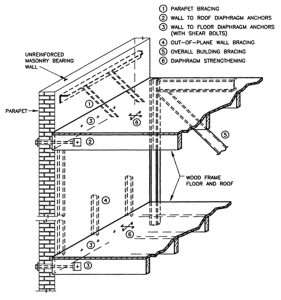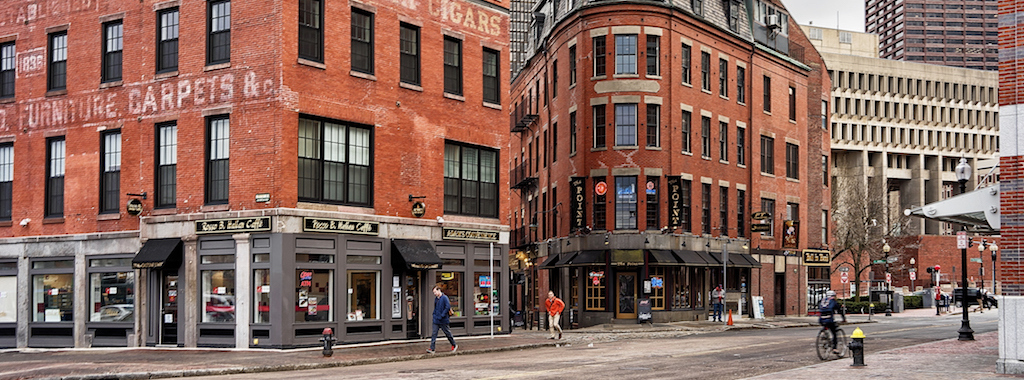Unreinforced masonry (URM) buildings in moderate- to high-seismic areas can be a disaster in waiting. These types of structures have very little of the ductility required of structures to prevent loss of life or business disruption in a seismic event. (Consult our Structural Engineering Blog post “Building Drift – Do You Check It?” for a discussion on ductility.) Many of these buildings are in densely populated areas, have historical meaning, provide important living or business spaces, and can be costly to retrofit. In this blog, Simpson Strong-Tie engineers discuss tools available for engineers to assess these buildings and design the retrofits needed to mitigate a potential loss of life and increase seismic resiliency.
This blog post was originally written by Sam Hensen, Simpson Strong-Tie vice president, Connectors and Lateral Systems, in April of 2013. It was updated to the most current codes on August 20, 2021, by Jeff Ellis, senior manager, Engineering – Codes and Compliance; Wendy Allen, manager, Field Engineering; and Kevin Davenport, manager, Field Engineering.
The International Existing Building Code (IEBC) Chapter A1 provides guidelines for the seismic retrofit of URM bearing wall buildings, including strength values for existing materials. The methodology includes designing the retrofit using 75% of seismic force for new buildings per ASCE 7. ASCE 41, Seismic Evaluation and Retrofit of Existing Buildings, is a Load and Resistance Factor Design (LRFD) approach to design, referenced in the IEBC, which in turn is referenced in the International Building Code (IBC). An excellent reference for those using ASCE 41 for retrofits is FEMA P-2006, Example Application Guide for ASCE 41-13, which was published in 2018. Additionally, designers should check with their local jurisdiction regarding any special requirements for existing building retrofits, including local policies or ordinances. Although the IEBC and ASCE 41 provide guidance and requirements for engineers in determining minimum seismic retrofits for these brittle structures, it’s recommended that design of URM building retrofits be performed by a qualified engineer with experience in URM retrofits.
Currently, the 2018 IEBC and 2015 IEBC have been adopted in 15 and 16 US states, respectively, as well as in several local areas (see reference map at the ICC website).
Many URM buildings in California metropolitan regions have been retrofitted. But there is much work to do in other seismic regions, such as non-metropolitan California, Alaska, Oregon, South Carolina, Tennessee, Utah, and Washington. When evaluating URM buildings, some key areas to consider are discussed in our workshops, upcoming Strong Retrofit webinar series, and shown on our URM building retrofit microsite.
1) URM Parapet Bracing:

A lot of damage to URM buildings can be attributed to parapet failures during or soon after a seismic event. Damage can occur not only to the building, but to nearby buildings. This poses a major life safety risk to building occupants and adjacent walkway users. Bracing the parapets is a must when evaluating the needed retrofitting of a URM building.
2) & 3) URM Wall Anchorage:
The URM walls must be tied to the horizontal diaphragms (roof and floors) to increase their ability to resist out-of-plane loading and catastrophic failures. There are many ways to anchor the walls to the diaphragms. Through-bolting with large bearing plates on the exterior can be used, but has visual challenges as well as egress restrictions. Epoxy anchor adhesives installed at an angle through multiple URM wall wythes (i.e., layers) will provide tensile and shear resistance, creating a connection between the wall and roof or floor. It is one of the most widely used methods. Grouted anchors have also been used for this application, but have less rigorous testing to back their use.

Determining the optimal location for these anchors can be challenging because many URM buildings utilize beam pockets to support the joists. The wall anchor will perform better when it is installed at a distance from the beam pocket. In selecting an anchor location, the midpoint between framing members is more ideal, but requires additional framing elements to attach to the joist.
4) URM Out-of-Plane Wall Bracing:
Once the walls have been anchored to the diaphragms, the unbraced length of unreinforced walls may cause them to buckle out of plane during lateral loading. Where the height-to-thickness ratio of the walls exceeds the limits given in the IEBC, additional bracing should be utilized between diaphragms to increase the out-of-plane strength of the URM wall assembly. This can be done by attaching steel or wood columns or strongbacks to the walls. Another option is to add fiber reinforced polymer (FRP) material to both the interior and exterior faces of the wall. The use of FRP material will also greatly increase the in-plane shear strength without adding weight to the building or taking up much space. There will be more discussion on this topic in the next section.
5) URM Lateral Shear Resistance:
Where URM walls lack sufficient shear strength to resist seismic loading, a traditional reinforced shotcrete method is often utilized to increase the in-plane shear strength of URM structures. Although effective, this method takes up space and adds a lot of weight to the structure, which increases the seismic load on the structure. This higher seismic force will impact all other key elements listed previously, and should be designed prior to evaluating the other areas. An alternative for increasing the in-plane shear strength of the URM wall assembly without increasing the structure weight and adding to the seismic demand is to utilize FRP material. Special detailing is required when attaching an impermeable element, such as FRP, to a porous URM wall.
In areas where there is little wall space (e.g., retail frontage with large openings), one should consider the installation of a steel special moment frame. These frames can be designed to resist large forces and have minimal impact on open space. See this link for more information.
6) URM Diaphragm strengthening
With most of the seismic load on the retrofitted URM structure being resisted by the wood diaphragms, it may be necessary to increase the diaphragm strength. This may require additional fastening or replacement of the diaphragm altogether.
(7) URM Veneer Anchoring and Stitching
URM structures may have missing or inadequate ties between masonry veneer wythes and/or between the veneer and the backup material. As an alternative to drilled adhesive dowels, the Simpson Strong-Tie Heli-Tie™ helical wall tie serves as a cost-effective retrofit veneer tie. The Heli-Tie is a stainless-steel helical tie that is easily installed into a predrilled hole. During the installation process, the ties are countersunk into the veneer face by way of the installation tool, making for an aesthetically pleasing appearance. In addition, the Heli-Tie helical stitching tie provides a unique solution for repairing and preserving damaged brick and masonry structures. Stitching ties can also be grouted into existing masonry joints to repair cracks and increase strength with minimum disturbance.
(8) Concrete Foundation
New foundation elements may have to be designed and built due to damage and/or inadequacy of existing foundation elements, or when they are required to support new structural elements that strengthen existing structural elements. Epoxy anchor adhesives offer a solution to connect new structural concrete elements to existing concrete or masonry elements. Additionally, if existing concrete foundation elements are damaged, structural epoxy repair may offer a solution.
These are just a few areas that should be considered by a building owner, along with a qualified engineer, when evaluating and strengthening a URM building. Implementing all the necessary seismic retrofits can go a long way toward protecting historic buildings, along with their adjacent structures, from serious damage while also greatly enhancing occupant safety.
Learn More About Unreinforced Masonry Retrofit Solutions with Simpson Strong-Tie Recorded URM Workshops
Unreinforced Masonry Building Retrofit Using Adhesive Anchorage, Shotcrete and Helical Ties
Detailing approaches include IEBC methods, with a nod to ASCE 41. Presenter: Wendy Allen, PE, Field Engineering Manager
Unreinforced Masonry Building Retrofit Using Connectors, Fasteners and Strong Frame® Moment Frames
An ASCE 41 connector design example is reviewed, as well as IEBC methods.
Presenter: Phillip Hui, PE, Branch Engineer
Concrete, CMU and URM Building Retrofits: FRP design basics for Gravity, Seismic & Wind Forces
FRP considerations for use on concrete and CMU structures and a brief case study of FRCM for URM Seismic retrofit. Approaches include IEBC and HBC designs.
Presenter: Sarah Outzen, PE, Field Engineer
Concrete Building Seismic Retrofit Using FRP
Seismic strengthening solutions for concrete buildings using FRP, including ASCE 41 design discussions and FEMA P-2006 examples. Also, new FRP diaphragm testing is presented.
Presenter: Aniket Borwankar, Development Manager, CSS





Designers studying church sanctuaries and similar large assembly spaces with tall walls and inadequate lateral bracing should consider steel interior pilasters, suitably trimmed-out to match interior decor, between each pair of large windows, connecting the wall planes to the horizontal ceiling and floor planes.
Historic buildings are exempt from the upgrade requirements, unless it is determined that they pose a life safety risk. This puts a huge amount of liability and responsibility on the person that makes that determination. Any thoughts?